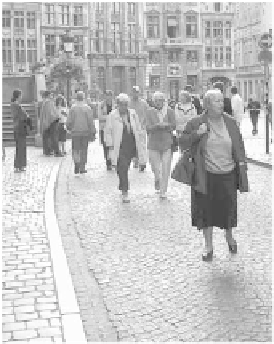Travel Reference
In-Depth Information
ORIENTATION
Six hundred years ago, Brussels was just a nice place to stop and
buy a waffle on the way to Bruges. With no strategic importance, it
was allowed to grow as a free trading town. Today, it's a city of 1.8
million, the capital of Belgium, the headquarters of NATO, and
the center of the European Union.
The Bruxelloise are cultured and genteel—even a bit snobby.
As the unofficial capital of Europe, the city is multicultural, host-
ing politicians and businessmen from around the globe and featur-
ing a world of ethnic restaurants.
Brussels enjoyed a Golden Age of peace and prosperity
(1400-1550) while England and France were duking it out in the
Hundred Years' War. It was then that many of the fine structures
that distinguish the city today were built. In the 1800s, Brussels
had another growth spurt, fueled by industrialization, wealth
taken from the Belgian Congo, and the exhilaration of the coun-
try's recent independence (1830).
Brussels speaks French. Bone up on
bonjour
and
s'il vous plaît
(see the French Survival Phrases in the appendix). Though the city
(and country) is officially bilingual and filled with foreign visitors,
80 percent of the locals speak French first and English second, if
at all. Language aside, the whole feel of the town is urban French,
not rural Flemish.
Because Brussels sits smack-dab between Belgium's two lin-
guistic groups (60 percent of Belgians speak Flemish, 40 percent
speak French), most of Brussels' street signs and maps are in both
languages. In this chapter, French names are generally used.
Tourists zipping between Amsterdam and Paris by train usu-
ally miss Brussels, but its rich, chocolaty mix of food and culture
pleasantly surprises those who stop.



















